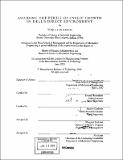Avoiding the perils of cyclic growth on Dell's direct environment
Author(s)
Albers, Toni Lynn, 1970-
DownloadFull printable version (9.433Mb)
Other Contributors
Leaders for Manufacturing Program.
Advisor
Donald Rosenfield and Stanley Gershwin.
Terms of use
Metadata
Show full item recordAbstract
The high technology industry suffers from a phenomenon that is common to many businesses and industries throughout the world - a "hockey-stick" demand skew. Such a skew derives its name from the shape of the quarterly demand curve as it is viewed across time. The demand curve is characterized by sales rates that are sluggish at the start of a quarter, before increasing dramatically by quarter-end, and then dropping off again after the close of the quarter. Despite its lauded Direct Model, Dell Computer Corporation is not exempt from issues concerning the hockey stick demand skew. A very definite quarterly skew exists for most of Dell's customer segments, particularly those in which a direct sales team is active. The author had the opportunity to spend seven months at Dell's facilities investigating this demand phenomenon. As an industry leader with their Direct Model, Dell's build-to-order strategy necessitates that systems are produced and shipped at a rate that closely mirrors the sales rate. The variability of a hockey-stick demand skew requires that the entire organization have the flexibility to adapt quickly to changes throughout the quarter. However, such flexibility does not come without a price. The end of quarter rush requires that manufacturing plan for excess capacity and work overtime to meet peak demand periods. Logistical costs rise due to the various expediting activities that must be undertaken. Accompanying these cost increases is a drop in gross margin at the end of the quarter as a result of changes and variability in procurement costs over the quarter. These factors effectively raise the marginal cost of systems built at the end of the quarter as compared to the beginning. In addition, an end-loaded sales demand places a large operational burden upon several pieces of the Dell organization. Manufacturing must not only be prepared with excess physical capacity at the end of a quarter, but must also have the necessary human resource capacity to accommodate these large swings in demand. These operational constraints provide a second impetus for a close examination of this issue at Dell. Finally, the greater the demand skew at Dell, the greater the financial risk for the company. The late demand swing is, in effect, a double-edged sword of risk for the organization. Not only does a large percentage of their demand for the quarter hit at once, but it hits at a time late in the quarter when there is little or no time to make up the difference if something were to happen. Any major disturbance within Dell's manufacturing structure, or that of their supply base, within the last two weeks of the quarter could have a unconstructive impact on unit volumes and total revenue for the quarter. For a company that is so intensely market driven, this is quite an unfavorable scenario. This triple nemesis of sub-optimal profitability, operational difficulties, and financial risk provided the impetus for this thesis work and project. Within Dell, the first order of business was to determine whether the hockey stick was internally or externally driven. After that determination was made, the author utilized non-linear programming tools to determine the optimal quarterly sales skew, based upon profitability measures. The final step was then to identify the drivers of the demand skew and to determine how they could best be manipulated to achieve the optimal skew. In this regard, Dell's Direct Model is notably well suited to the task. Without an intricate, multi-layered sales channel, alterations can easily be made within the sales and marketing arena that can immediately and dramatically change the visage of the quarterly sales skew.
Description
Thesis (M.B.A.)--Massachusetts Institute of Technology, Sloan School of Management; and, (S.M.)--Massachusetts Institute of Technology, Dept. of Mechanical Engineering; in conjunction with the Leaders for Manufacturing Program, Massachusetts Institute of Technology, 2000. Includes bibliographical references (leaves 85-86).
Date issued
2000Department
Leaders for Manufacturing Program at MIT; Massachusetts Institute of Technology. Department of Mechanical Engineering; Sloan School of ManagementPublisher
Massachusetts Institute of Technology
Keywords
Sloan School of Management., Mechanical Engineering., Leaders for Manufacturing Program.